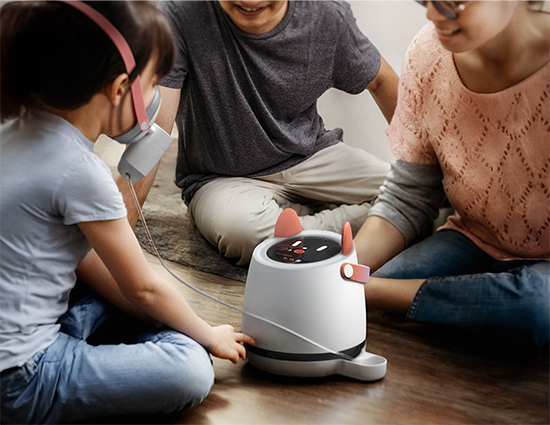Designing a medical device is a challenging creative task. Not only must it be safe, reliable, easy to use and have market appeal, the device must be accepted into people’s lives and lifestyles. After many years collaborating with talented design colleagues at Cambridge Consultants, I’ve considered several ways to rise to the challenge. And for me, the overriding imperative is to elevate your thinking to an emotional level.
As a medical industrial designer, you are working in the world’s most tightly regulated industry. Quite rightly, development is characterised by an aversion to risk and a focus on safety. But that shouldn’t mean that we designers play safe and constrict our creativity. Yes, we will always design devices to meet functional, safety, usability and commercial needs. But it’s possible to really challenge boundaries and craft truly engaging experiences when we consider the emotional effects that our products create.
It is the users who are central to all this. Medical devices are used by the broadest range of people, each with their very particular needs and expectations. Often, they are not given the choice over the product they are prescribed, even though they may end up relying on it every single day for a very long time. Yet a beautifully designed device can make a positive difference when it integrates neatly into their everyday life. Crucially, if someone likes using their device, that connection can influence positive behaviours. Compliance and adherence to the drug regime will improve – and so will health outcomes.
So, for me the ultimate goal for medical designers must be to create product design with experiences that excite and delight their users. That’s what I mean by successful medical device design, and these are my top six insights to help achieve it.
Want to discuss further?
1. Keep user experience simple
Simplicity is about more than creating effortless style. It is a fundamental design principle that considers the user with a view to creating something that is accessible and easily understood. When a designer is asked to answer the needs of multiple stakeholders, it can be tempting to add more features and functionality to please everyone.
Every extra is likely to have a trade-off. We should assess the value of each addition against the complexity it might add – whether technically or to the user experience. If the feature is not worth the trade-off, then obviously it shouldn’t be added. On one hand, additional features can provide more options for customisation. But on the other, they can actually be a burden for the user. A product that is free from options and decision-making can offer a more effortless and enjoyable experience.
2. Get the product design details right
In an industry where safety is paramount, every design decision we make can influence user behaviour, so each detail must be considered and justified. The specification of every colour and finish or shade and texture needs to be exactly right. If the visual language is correct, then the device will evoke positive emotion, instil trust, inspire positive behaviours and ultimately encourage correct use.
I’ve deliberated with my design team over the most suitable tone of gold for an autoinjector feature to convey elegance and high performance. We’ve spent time refining a shade of green for a home diagnostic device to associate it with nature rather than the military. And we’ve carefully considered the frequency of a pulsing light to suggest a gentle reminder rather than an urgent warning. Designing with such meticulous attention to detail creates positive connections with users.
3. Engage with your users
I can’t over stress the importance of making those positive connections. Often, users will have a negative preconception before they encounter our product. They might consider the therapy to be invasive, painful or complicated to set up. They might have had a bad experience with a similar product or be daunted by the length of treatment involved. All these factors, together with therapies that do not offer immediate health benefits, can contribute to poor compliance.
While we might not be able to change the nature of the therapy, we do have the power to support the needs of users and provide more engaging experiences. Our development of the Novartis Extavia® autoinjector for the treatment of multiple sclerosis is a case in point. We worked creatively to turn preconceptions into positive feelings by integrating a sympathetic and approachable visual language. Taking a holistic approach, we simplified and clarified the Instructions for Use, modernised the carry case to better integrate with users’ lifestyles, softened areas that touch the skin and even reduced the noise of the injection.
4. Integrate it into users’ lifestyles
A thoughtful design that considers users’ physical and emotional needs can bring joy and make a meaningful difference to real lives. As part of user research for the TOBI® Podhaler® project, I spoke to very poorly children, teenagers and young adults who suffered from cystic fibrosis. Their overriding desire was simply to fit in and be normal – to blend in completely with their healthy peers. They wanted a convenient therapy kit that didn’t remind them of their condition and wouldn’t look out of place in their bedroom.
The TOBI Podhaler successfully changed the way the medication was administered, replacing a nebuliser with a dry powder capsule inhaler. Our achievement was refreshing the TOBI brand and building a positive user experience. The packaging was vital to introduce the therapy, guide users through the new use steps and integrate the product into their lifestyle. We created a cheerful aesthetic for both product and packaging that looked discreet in the home but reassuringly medical when used in public. Every detail of the design was user tested and refined several times over.
5. Futureproof medical device design
Earlier I mentioned the importance of challenging convention. I believe in this passionately – just as I do the need to balance it with modernity. Medical products often take a long time to bring to market and then have a considerable lifespan. Following trends has no place here. The key is to create timeless appeal that transcends the latest fashions. Every project brings an opportunity to create a novel design language, a fresh look and feel. We shouldn’t follow design trends we should set them. Creating a timeless aesthetic that connects emotionally will ensure that our designs stand the test of time.
This approach can be enhanced by focusing on the opportunities to incorporate adaptable assets. This could include changeable caps, handles or label graphics. It might be designing flexible elements into the user interface for future updates to refresh the look and feel of the device. An added bonus is that adaptable assets can be useful on a platform device to differentiate drug brands – a great way of supporting brand expansion.
6. Consider the environment
Humanity’s demand for a sustainable future is putting increasing pressure on our industry to tackle obvious issues such as disposable plastic components and excessive packaging. I believe that to make a significant difference, we need to take radical steps.
Making small reductions to the amount of material used or switching to slightly more sustainable materials or production processes can only ever be step changes. Let’s be bold. I advocate replacing all printed Instructions for Use leaflets with digital versions where possible. I know this is a huge hurdle to negotiate. But given today’s almost universal access to digital technology, pressure should be put on regulators to allow more flexibility in conveying key information. Meanwhile, let’s keep taking those incremental steps at every opportunity.
To sum up…
In the risk-averse world of medical design, our responsibility as designers is to challenge the boundaries with creative thinking that delivers the best possible experiences for our users. Achieving success is not down to any single ingredient, it comes from a holistic approach to balancing and answering stakeholder needs. Once we’ve met these needs we must strive for the next level and create experiences that resonate emotionally – delightful experiences that people will want to return to again and again.





